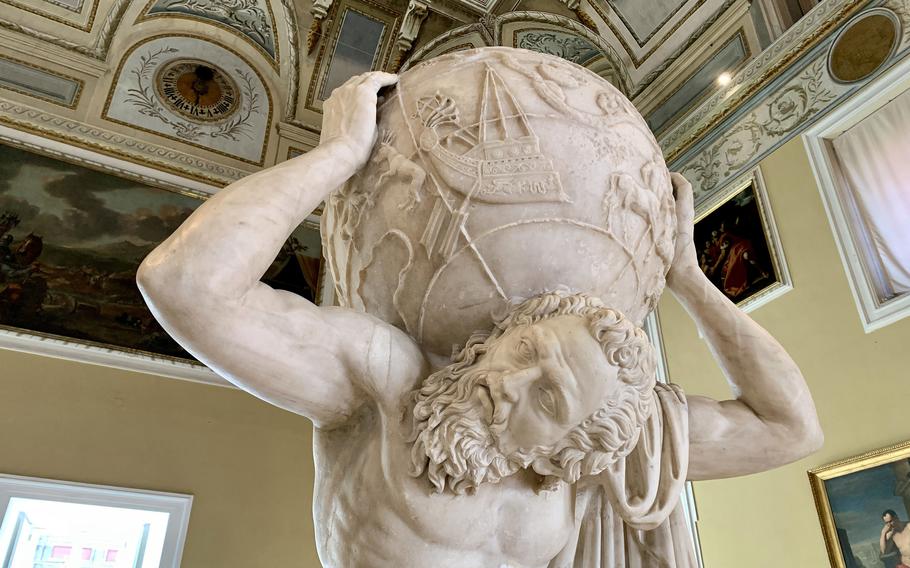
A marble statue of Atlas dated to the 2nd century in the National Archeological Museum of Naples, located in the Palazzo del Mann. (Alison Bath/Stars and Stripes)
No trip to see the ruins of the ancient Roman city of Pompeii is complete without a visit to the renowned National Archeological Museum of Naples.
Hundreds of artifacts found amid the destruction after the cataclysmic eruption of Mount Vesuvius in A.D. 79 are housed at the museum about 16 miles from the archaeological site of Pompeii.
Situated in the Rione Sanita neighborhood, the museum encompasses five levels of the Palazzo del Mann, a former royal cavalry barracks that later housed the University of Naples until 1777.
The building subsequently was enlarged and refurbished to accommodate an impressive collection of Greco-Roman antiquities amassed by Alexander Farnese, who became Pope Paul III in 1534, and artifacts discovered in Pompeii and other Vesuvian towns.
The everyday lives of aristocrats, merchants, domestic workers, slaves and others killed in the legendary blast can be experienced through the paintings, sculptures, bronze works, household items and other objects they left behind.
The museum’s collection also includes Egyptian artifacts from antiquity and a compendium of ancient inscriptions. Unfortunately, on my recent visit, the basement floor housing the Egyptian statues, funeral objects and other treasures was closed.
There also wasn’t a map of the museum readily available, although a printable version in English and Italian can be found online. In addition, a hardbound guide in both languages is for sale for 24 euros.
Entering the museum on the ground level, visitors first see an imposing marble statue of Marcus Nonius Balbus on horseback discovered at Herculaneum, present-day Ercolano. The statue, dated to 20 B.C., is one of many honors erected in the city to the prominent patron.
On the same floor, which is also known as the zero level, are Greco-Roman antiquities, including marble and bronze sculptures, from the area around Naples and the impressive Farnese collection, featuring a sculpture of the ancient goddess Artemis.
You also can see the Farnese Bull, a massive sculpture of yellowish white marble depicting the murder of the Greek nymph Dirce by the twin sons of Zeus, Amphion and Zethus, in the presence of their mother, Antiope, dated to the early third century.
Up one floor on the first level are the mosaics of the House of the Faun, a luxurious villa in Pompeii. The stunning collection, salvaged from the ruins of the city’s largest home, includes an immense mosaic titled “Battle of Alexander Against Darius,” which originally was installed on the floor of the residence.
Don’t miss the “Female Portrait,” with its tiny mosaic pieces, and “Memento Mori,” an allegory of death dated to the mid-first century B.C.
On the second level, visitors will find the immense Hall of the Sun Dial. Among its artworks is a second-century marble sculpture of the Greek titan Atlas holding the globe.
The level also includes a room-sized, three-dimensional diorama of Pompeii, artifacts from the Temple of Isis and displays of household items — such as glassware, dishes, pots and jugs — and military equipment.
Also nearby are a collection of frescoes that document Roman painting in the Vesuvius area between the first century B.C. and the first century A.D., according to the museum.
Among them are “Flora,” which depicts the Roman goddess of spring, flowers and fertility and was discovered in the Villa di Arianna in the ancient town of Stabiae, and “Dancers” from the Villa di Cicero in Pompeii.
For visitors in need of a break from touring the museum’s wonders, two garden areas and a cafe offering drinks and light snacks present an opportunity to reflect.
With much to see and ponder, the National Archeological Museum of Naples is a great way to spend a morning or afternoon learning more about ancient Roman civilization in southern Italy.
National Archeological Museum of Naples
Address: Piazza Museo Nazionale 19, Naples, Italy. There are stops for the museum on metro lines 1 (Museo stop) and 2 (Piazza Cavour stop).
Cost: 20 euros; free for children 17 and under. The museum is open for free to everyone on the first Sunday of each month.
Hours: 9 a.m.-7:30 p.m., Wednesday-Monday; closed on Tuesdays and Christmas Day; check museum website for reduced hours on Christmas Eve, New Year’s Eve and New Year’s Day.
Information: Online: museoarcheologiconapoli.it